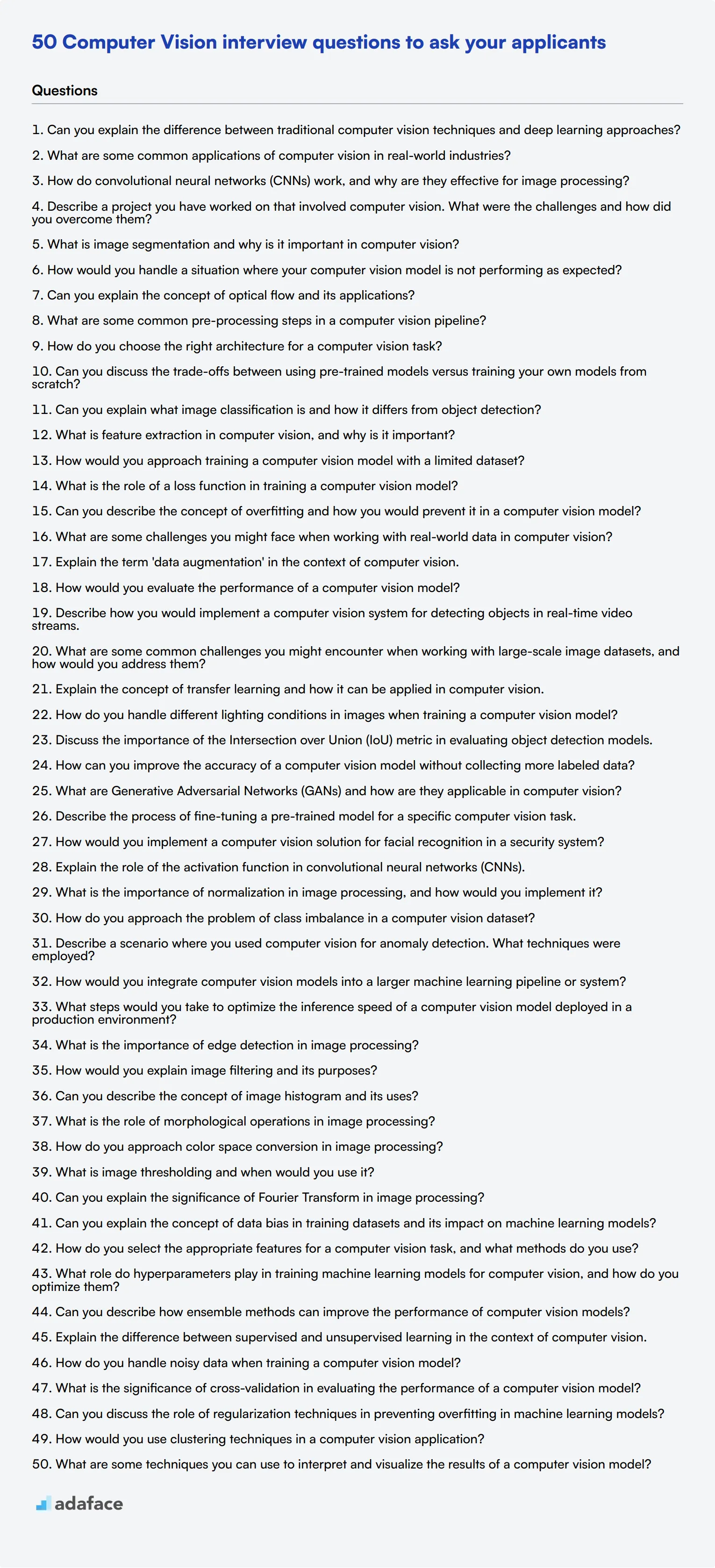Hiring for a Computer Vision role requires asking the right questions to assess your candidates' knowledge and skills effectively. This is particularly important given the intricacies and evolving nature of the field, much like the skills needed for a machine learning engineer.
In this blog post, we provide a comprehensive list of interview questions tailored for different expertise levels in Computer Vision. This includes questions for junior, mid-tier engineers, and those specifically focused on image processing and machine learning algorithms.
Using these targeted questions, you can better evaluate the technical aptitude of your candidates. For a more in-depth assessment, consider utilizing our specialized Computer Vision test before conducting interviews.
Table of contents
10 common Computer Vision interview questions to ask your applicants
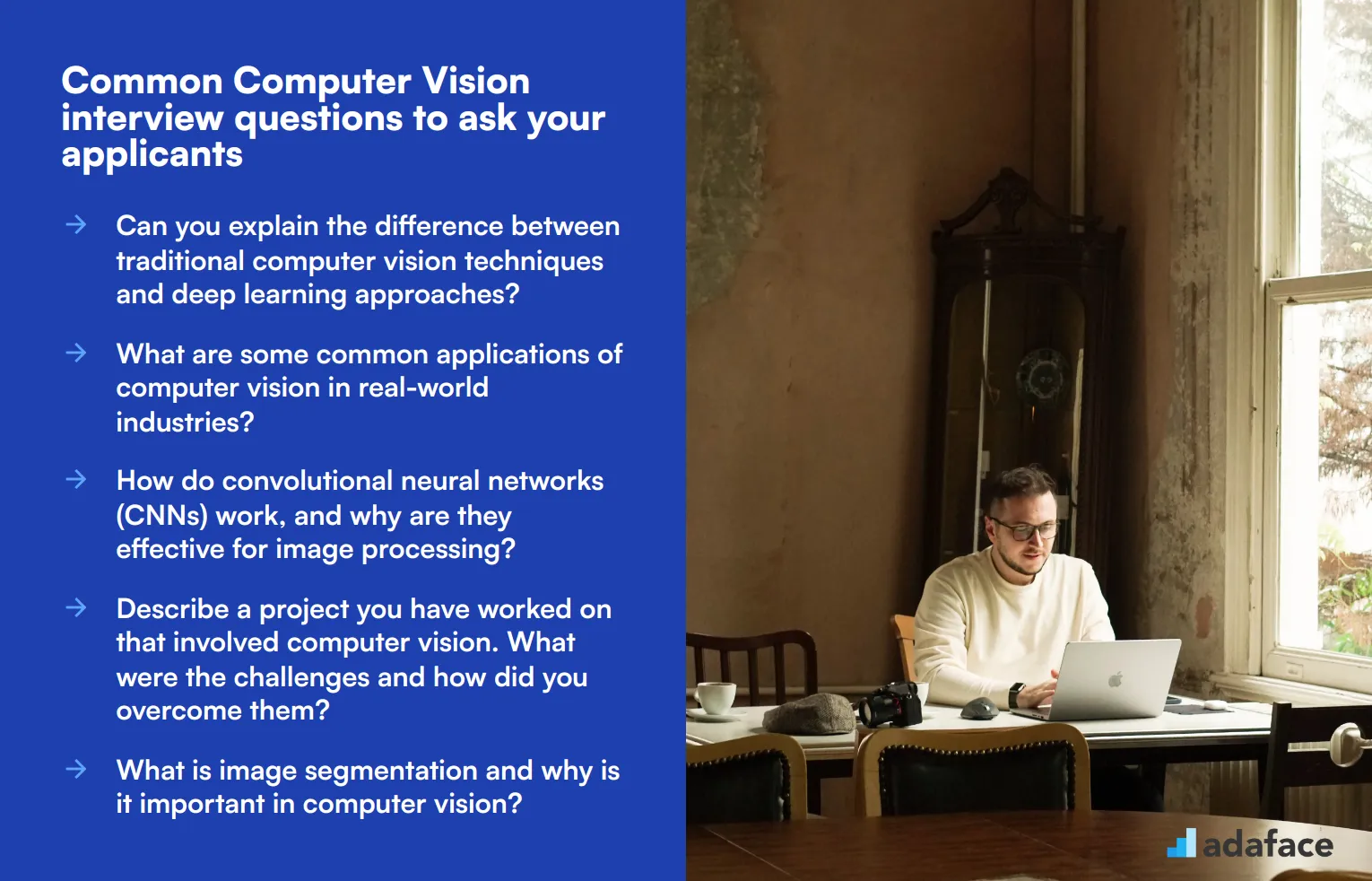
To determine whether your applicants have the right skills for computer vision roles, use these interview questions to evaluate their technical knowledge and problem-solving abilities. This list will help you identify candidates who are well-versed in the complexities of computer vision, ensuring you select the best fit for your team. For more on hiring technical roles, explore the skills required for machine learning engineers.
- Can you explain the difference between traditional computer vision techniques and deep learning approaches?
- What are some common applications of computer vision in real-world industries?
- How do convolutional neural networks (CNNs) work, and why are they effective for image processing?
- Describe a project you have worked on that involved computer vision. What were the challenges and how did you overcome them?
- What is image segmentation and why is it important in computer vision?
- How would you handle a situation where your computer vision model is not performing as expected?
- Can you explain the concept of optical flow and its applications?
- What are some common pre-processing steps in a computer vision pipeline?
- How do you choose the right architecture for a computer vision task?
- Can you discuss the trade-offs between using pre-trained models versus training your own models from scratch?
8 Computer Vision interview questions and answers to evaluate junior engineers
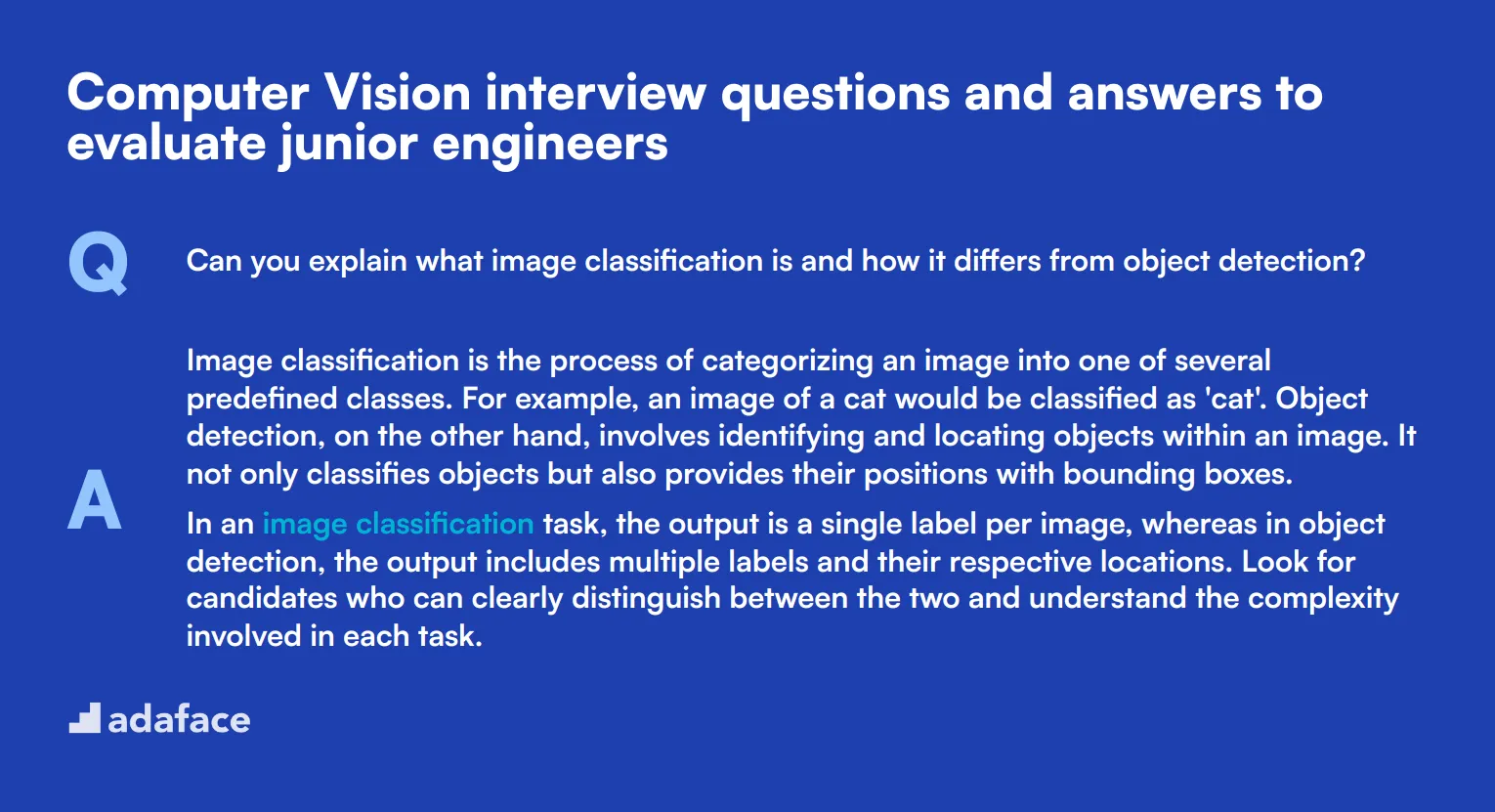
To accurately gauge a candidate's foundational knowledge and practical skills in computer vision, use these interview questions tailored for junior engineers. These questions will help you identify their understanding of core concepts and their ability to apply them in real-world scenarios.
1. Can you explain what image classification is and how it differs from object detection?
Image classification is the process of categorizing an image into one of several predefined classes. For example, an image of a cat would be classified as 'cat'. Object detection, on the other hand, involves identifying and locating objects within an image. It not only classifies objects but also provides their positions with bounding boxes.
In an image classification task, the output is a single label per image, whereas in object detection, the output includes multiple labels and their respective locations. Look for candidates who can clearly distinguish between the two and understand the complexity involved in each task.
2. What is feature extraction in computer vision, and why is it important?
Feature extraction involves identifying key characteristics or attributes from an image that are useful for analysis or classification. These features can be edges, textures, shapes, or more complex attributes derived from the image.
Effective feature extraction is crucial because it simplifies the image data and makes it easier for algorithms to perform tasks like classification, detection, or recognition. Look for candidates who can articulate the importance of this process and maybe provide examples of features commonly used in practical applications.
3. How would you approach training a computer vision model with a limited dataset?
Training a computer vision model with a limited dataset can be challenging. One approach is to use data augmentation techniques to artificially increase the size of your dataset. This can include transformations like rotations, flips, and color adjustments.
Another effective method is to use transfer learning, where you take a pre-trained model and fine-tune it with your limited dataset. Look for candidates who can discuss these strategies and understand their practical implications in improving model accuracy.
4. What is the role of a loss function in training a computer vision model?
A loss function measures the difference between the predicted output and the actual target values. It provides a way to evaluate how well a model is performing and guides the optimization process during training.
The choice of loss function can significantly impact the performance of the model. For example, for classification tasks, Cross-Entropy Loss is commonly used, while for regression tasks, Mean Squared Error is more appropriate. Look for candidates who can explain the significance of the loss function and its role in model optimization.
5. Can you describe the concept of overfitting and how you would prevent it in a computer vision model?
Overfitting occurs when a model learns the noise and details in the training data to the extent that it performs poorly on new, unseen data. This usually happens when the model is too complex relative to the size of the training dataset.
To prevent overfitting, you can use techniques such as cross-validation, data augmentation, and dropout. Regularization methods like L2 regularization can also help. Candidates should show awareness of these techniques and ideally provide examples of how they have applied them in past projects.
6. What are some challenges you might face when working with real-world data in computer vision?
Real-world data is often noisy, inconsistent, and unstructured. Challenges include dealing with varying lighting conditions, occlusions, and different perspectives. Data may also contain irrelevant or redundant information that needs to be filtered out.
Successful candidates will discuss strategies for preprocessing data to make it more usable, such as normalization, filtering, and augmentation. They should also be able to articulate how they would handle specific challenges like dealing with occlusions or varying lighting conditions.
7. Explain the term 'data augmentation' in the context of computer vision.
Data augmentation refers to the techniques used to increase the size and variability of a training dataset without actually collecting new data. This is achieved by applying random transformations to the existing data, such as rotations, flips, color adjustments, and cropping.
Data augmentation helps improve the robustness and generalization capability of a computer vision model by exposing it to a wider variety of scenarios during training. Look for candidates who can discuss specific augmentation techniques and explain their benefits in enhancing model performance.
8. How would you evaluate the performance of a computer vision model?
Evaluating a computer vision model involves using metrics that are appropriate for the specific task. Common metrics include accuracy, precision, recall, and F1-score for classification tasks. For object detection, Intersection over Union (IoU) and mean Average Precision (mAP) are often used.
Candidates should also mention the importance of using a separate validation dataset to ensure the model's performance generalizes well to unseen data. They should be able to explain why these metrics are important and how they provide insights into the model's strengths and weaknesses.
15 intermediate Computer Vision interview questions and answers to ask mid-tier engineers
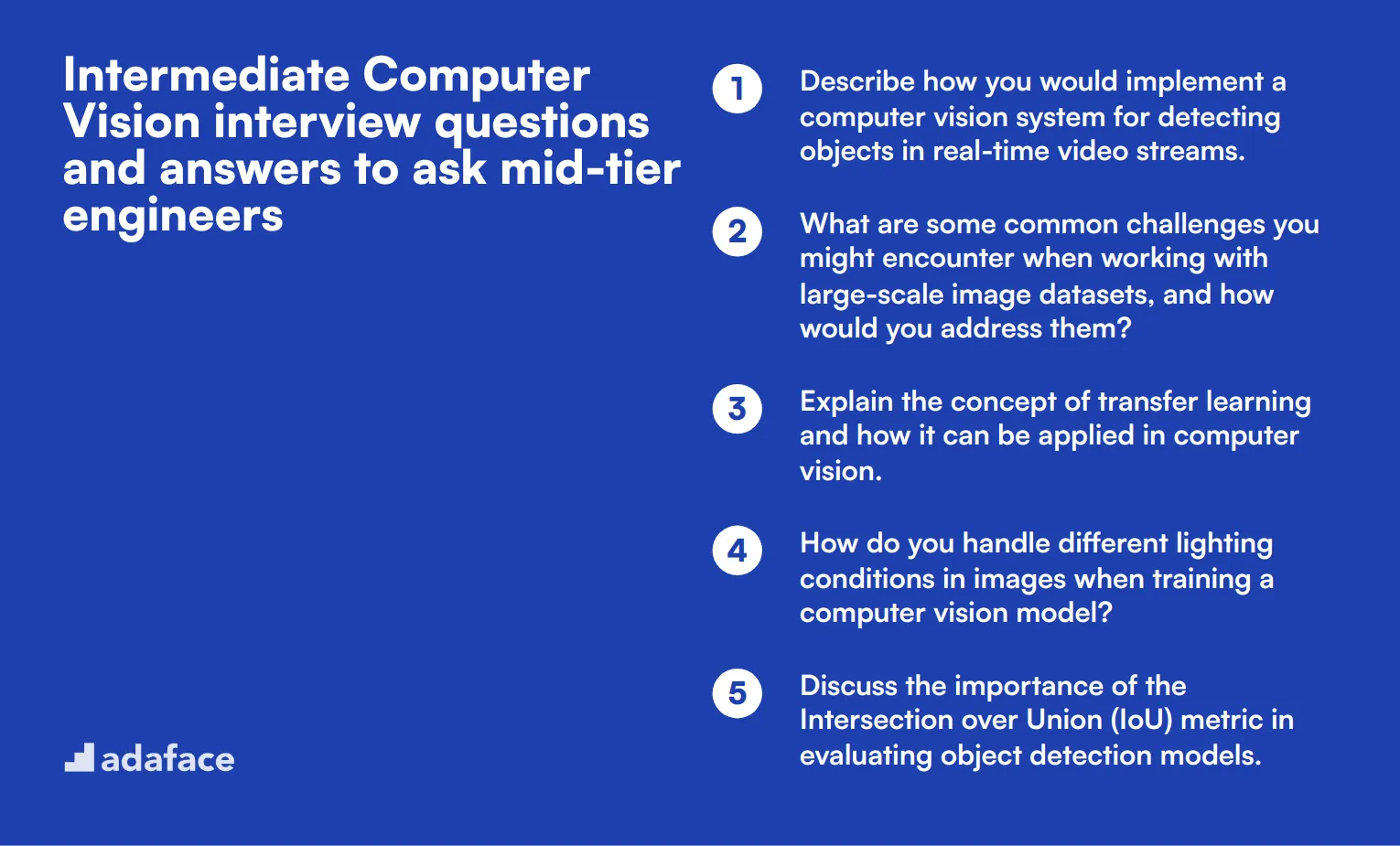
To determine whether your applicants have the right skills to handle intermediate-level tasks in computer vision, ask them some of these 15 computer vision interview questions. These questions help identify candidates who not only understand the fundamental concepts but can also apply them to solve practical problems efficiently.
- Describe how you would implement a computer vision system for detecting objects in real-time video streams.
- What are some common challenges you might encounter when working with large-scale image datasets, and how would you address them?
- Explain the concept of transfer learning and how it can be applied in computer vision.
- How do you handle different lighting conditions in images when training a computer vision model?
- Discuss the importance of the Intersection over Union (IoU) metric in evaluating object detection models.
- How can you improve the accuracy of a computer vision model without collecting more labeled data?
- What are Generative Adversarial Networks (GANs) and how are they applicable in computer vision?
- Describe the process of fine-tuning a pre-trained model for a specific computer vision task.
- How would you implement a computer vision solution for facial recognition in a security system?
- Explain the role of the activation function in convolutional neural networks (CNNs).
- What is the importance of normalization in image processing, and how would you implement it?
- How do you approach the problem of class imbalance in a computer vision dataset?
- Describe a scenario where you used computer vision for anomaly detection. What techniques were employed?
- How would you integrate computer vision models into a larger machine learning pipeline or system?
- What steps would you take to optimize the inference speed of a computer vision model deployed in a production environment?
7 Computer Vision interview questions and answers related to image processing
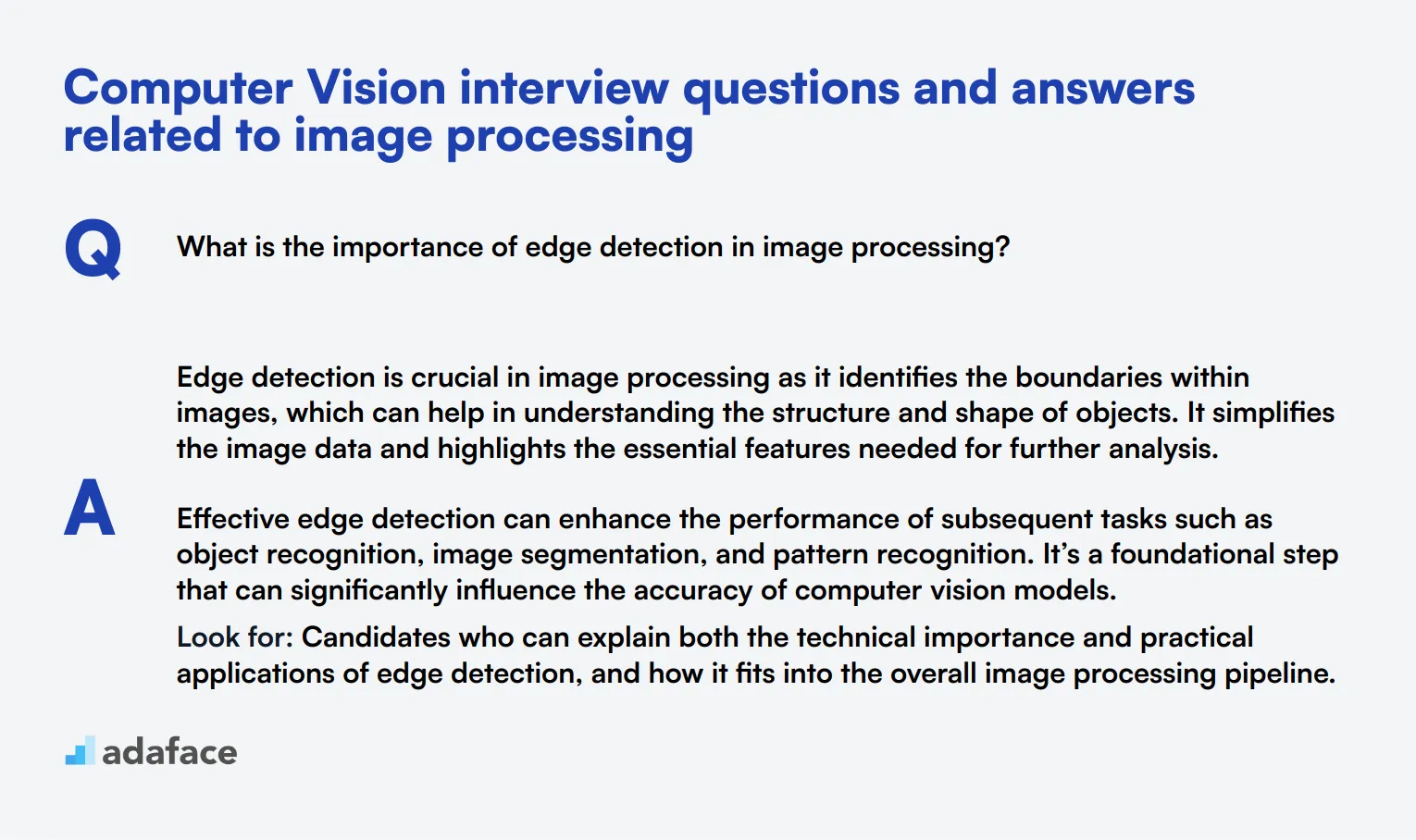
To gauge whether your candidates have the right image processing skills within the realm of computer vision, present them with these 7 targeted interview questions. These questions are designed to assess their understanding and practical know-how, making your hiring process more effective and straightforward.
1. What is the importance of edge detection in image processing?
Edge detection is crucial in image processing as it identifies the boundaries within images, which can help in understanding the structure and shape of objects. It simplifies the image data and highlights the essential features needed for further analysis.
Effective edge detection can enhance the performance of subsequent tasks such as object recognition, image segmentation, and pattern recognition. It’s a foundational step that can significantly influence the accuracy of computer vision models.
Look for: Candidates who can explain both the technical importance and practical applications of edge detection, and how it fits into the overall image processing pipeline.
2. How would you explain image filtering and its purposes?
Image filtering involves modifying or enhancing an image by emphasizing certain features or removing unwanted noise. Common purposes include noise reduction, edge enhancement, and blurring.
Different types of filters, such as Gaussian, Median, and Sobel, serve various purposes. For instance, Gaussian filters are used for smoothing images, while Sobel filters are used for edge detection.
Look for: An ideal candidate should provide examples of different filters and their specific uses, demonstrating practical knowledge of when and how to apply them effectively.
3. Can you describe the concept of image histogram and its uses?
An image histogram is a graphical representation showing the distribution of pixel intensity values. It provides insights into the contrast, brightness, and intensity distribution of an image.
Histograms are instrumental in tasks like image equalization, thresholding, and contrast adjustment, helping to enhance image quality and extract meaningful information.
Look for: Candidates who can explain how histograms are interpreted and used in practical scenarios to adjust and improve image attributes.
4. What is the role of morphological operations in image processing?
Morphological operations, such as dilation, erosion, opening, and closing, are used to process binary images by probing their structure. These operations help in removing noise, filling gaps, and separating connected objects.
For example, erosion removes small noise points, while dilation can help in bridging small gaps. Opening and closing are combinations of erosion and dilation that are used to refine the shapes within an image.
Look for: An understanding of how these operations modify image structures and the ability to provide practical examples of their application in image processing tasks.
5. How do you approach color space conversion in image processing?
Color space conversion involves changing an image from one color space to another, such as from RGB to grayscale or HSV. This is often done to simplify image analysis or to highlight specific features.
For example, converting to grayscale can reduce computational complexity, while converting to HSV can make it easier to isolate color-based features.
Look for: Candidates who can explain the reasons behind using different color spaces and how these conversions can benefit various image processing tasks.
6. What is image thresholding and when would you use it?
Image thresholding transforms a grayscale image into a binary image by setting a threshold value. Pixels with intensity values above the threshold are set to one value (e.g., white), and those below are set to another value (e.g., black).
Thresholding is commonly used in object detection and segmentation, where it helps to distinguish objects from the background.
Look for: A clear explanation of different thresholding techniques (e.g., global, adaptive) and their appropriate use cases in image processing.
7. Can you explain the significance of Fourier Transform in image processing?
The Fourier Transform decomposes an image into its sine and cosine components, effectively converting it from the spatial domain to the frequency domain. This helps in analyzing the frequency characteristics of the image.
It is particularly useful for noise reduction, image compression, and feature extraction, as it allows for the manipulation of specific frequency components.
Look for: Candidates who understand both the theoretical and practical aspects of the Fourier Transform, and can discuss its applications in various image processing tasks.
10 Computer Vision interview questions about machine learning algorithms
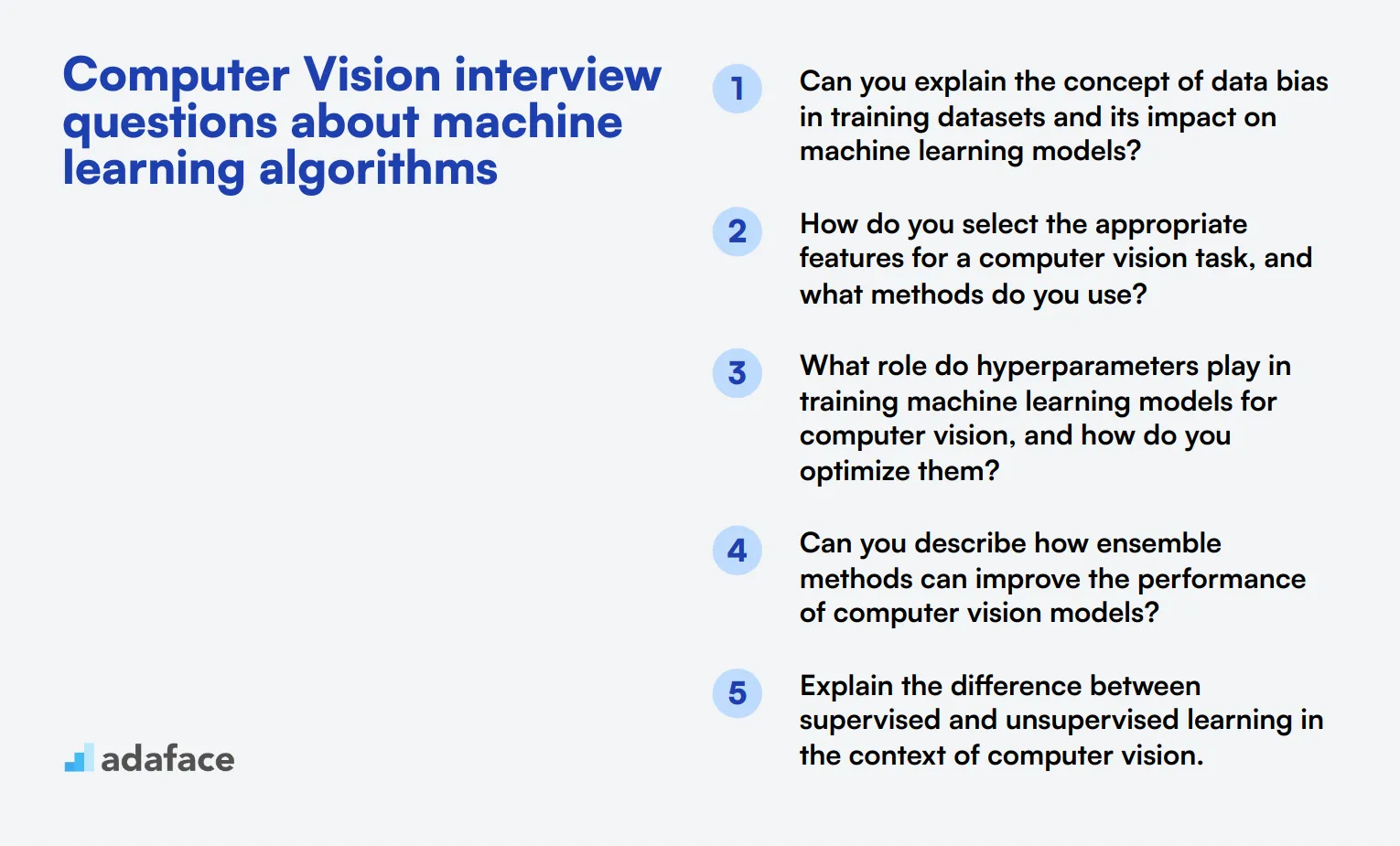
To assess whether your candidates possess the necessary skills for computer vision tasks, consider using this collection of targeted questions about machine learning algorithms. These questions will help you evaluate their understanding of key concepts and their ability to apply them in real-world scenarios, particularly in roles such as machine learning engineer.
- Can you explain the concept of data bias in training datasets and its impact on machine learning models?
- How do you select the appropriate features for a computer vision task, and what methods do you use?
- What role do hyperparameters play in training machine learning models for computer vision, and how do you optimize them?
- Can you describe how ensemble methods can improve the performance of computer vision models?
- Explain the difference between supervised and unsupervised learning in the context of computer vision.
- How do you handle noisy data when training a computer vision model?
- What is the significance of cross-validation in evaluating the performance of a computer vision model?
- Can you discuss the role of regularization techniques in preventing overfitting in machine learning models?
- How would you use clustering techniques in a computer vision application?
- What are some techniques you can use to interpret and visualize the results of a computer vision model?
Which Computer Vision skills should you evaluate during the interview phase?
In a single interview, assessing every aspect of a candidate's Computer Vision expertise can be challenging. However, focusing on specific core skills can provide invaluable insights into their capabilities and potential contributions to your team.
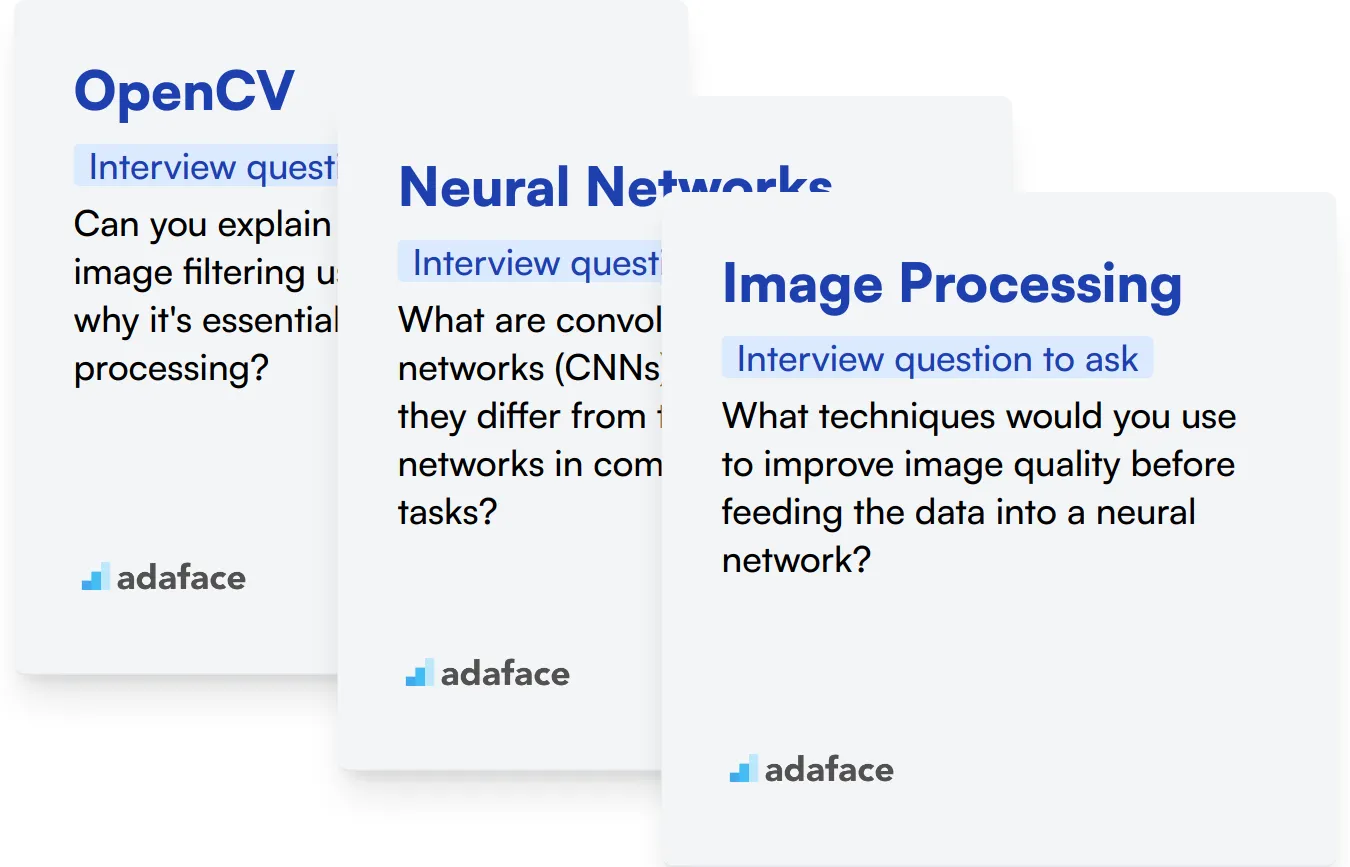
OpenCV
Consider utilizing an assessment that includes relevant multiple-choice questions (MCQs) on OpenCV to filter candidates effectively. Our OpenCV test offers a comprehensive evaluation of this skill.
In addition to a skills assessment, you can ask targeted interview questions to gauge their understanding of OpenCV.
Can you explain how to perform image filtering using OpenCV and why it's essential in image processing?
Look for candidates who can clearly describe the steps involved in image filtering and articulate the importance of this technique in enhancing image quality and feature extraction.
Neural Networks
Administering a test that includes MCQs on neural networks can help you assess this important skill. Our Neural Networks test can serve as an effective screening tool.
You may also want to ask interview questions that target their understanding of neural networks.
What are convolutional neural networks (CNNs), and how do they differ from traditional neural networks in computer vision tasks?
Evaluate their ability to explain the architecture of CNNs and their application in image classification and object detection, which are key areas in computer vision.
Image Processing
To effectively assess this skill, consider integrating MCQs focused on image processing techniques into your interviewing process. Our Image Processing test can serve as a valuable resource.
Asking specific questions about image processing during the interview can provide deeper insight into a candidate's expertise.
What techniques would you use to improve image quality before feeding the data into a neural network?
Look for responses that include various preprocessing techniques, such as normalization, resizing, and noise reduction, which are essential for effective model training.
Hire top talent with Computer Vision skills tests and the right interview questions
If you're looking to hire someone with Computer Vision skills, you need to ensure they possess the skills accurately.
The best way to do this is to use skill tests. Consider using our Computer Vision Test or OpenCV Online Test.
Once you use these tests, you can shortlist the best applicants and invite them for interviews.
Next, sign up to get started or visit our test library for more options.
Computer Vision Test
Download Computer Vision interview questions template in multiple formats
Computer Vision Interview Questions FAQs
The questions cover common topics, junior and mid-tier engineer assessments, image processing, and machine learning algorithms in Computer Vision.
These questions can help evaluate candidates' knowledge and skills in Computer Vision, allowing recruiters to make informed hiring decisions.
Yes, the questions are categorized for junior engineers, mid-tier engineers, and cover various aspects of Computer Vision.
Interviewers should select questions based on the candidate's experience level and the specific requirements of the role.

40 min skill tests.
No trick questions.
Accurate shortlisting.
We make it easy for you to find the best candidates in your pipeline with a 40 min skills test.
Try for freeRelated posts
Free resources




